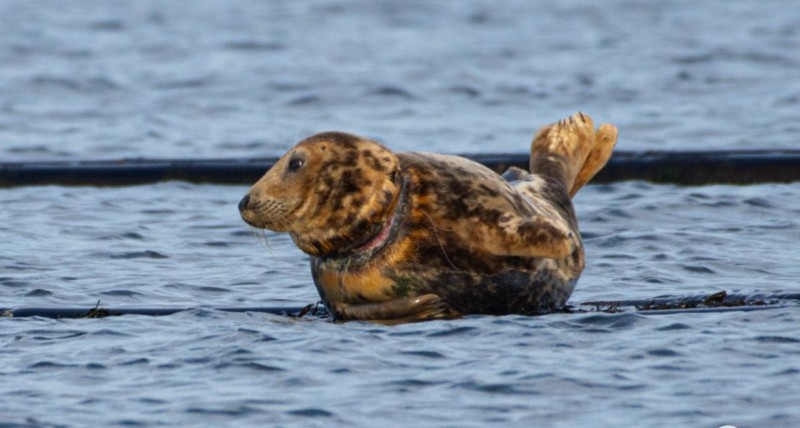With 12.3% of marine protected areas (MPAs) in 2022 (excluding overseas territories), the European Union is gradually progressing toward its goal of 30% by 2030. However, MPAs represent very different realities depending on the country.
Marine Protected Area Coverage in the EU
(Percentage of maritime space in 2022)

MPAs, broadly defined by the International Union for Conservation of Nature (IUCN), are “a clearly defined geographical space, recognized, dedicated, and managed, by legal or other effective means, to ensure the long-term conservation of nature, ecosystem services, and associated cultural values.”
If a marine area does not meet this definition, it cannot be considered a Marine Protected Area. The IUCN notes that these zones provide ecosystem services that help mitigate climate change—for example, seas and oceans act as carbon sinks.
A Term Covering a Heterogeneous Reality
MPAs are geographically defined marine zones aimed at protecting marine biodiversity and managing maritime activities sustainably. They do not necessarily ban human activities such as fishing or tourism, except in areas with very high protection levels.
In the EU, most MPAs are part of the Natura 2000 network, launched in 1992 and based on the Habitats and Birds Directives. The Habitats Directive requires member states to take appropriate measures to prevent the deterioration of natural habitats and significant disturbance to species for which the site is designated. The Birds Directive protects wild bird populations, including in coastal and littoral areas.
Natura 2000 sites are not the only ones counted by Eurostat; many countries also designate protected areas at the national level. Thus, in 2022, 12.3% of European maritime waters were protected either nationally or through Natura 2000 (excluding overseas territories), covering approximately 629,000 km² of marine territory.

Competent authorities in each member state define conservation measures for sites: banning seabed extraction activities, regulating fishing, or controlling infrastructure construction. As explained by the NGO WWF, these measures help protect and even restore marine biodiversity. For example, banning fishing in strictly protected zones allows fish populations to reproduce before larvae disperse via currents, helping replenish fisheries.
Country Rankings and Notable Areas
Germany has the largest Natura 2000 marine network, with 45.2% of its waters protected under the European network. France ranks first when national MPAs, those under regional sea conventions (joint measures between countries sharing maritime zones, e.g., the Mediterranean), and other designations are included.
Indeed, some “national” protected areas designated by member states are not counted in Natura 2000. Some states have national conservation measures predating Natura 2000. In France, for example, the French Office for Biodiversity (OFB) manages national nature reserves, marine natural parks, and coastal conservatories.
Belgium ranks third (37.8%), followed by the Netherlands (26.8%). The countries with the smallest protected marine areas in 2022 were Ireland (2.1%) and Slovenia (5.4%).
France’s Second Largest Marine Reserve in the World
France has one of the largest maritime territories in the EU and the largest area of MPAs (including overseas territories). Since 2022, the Terres australes françaises (TAF) National Nature Reserve has expanded to cover all maritime areas of the Crozet and Kerguelen archipelagos and the Saint-Paul and Amsterdam islands, administered by the French Southern and Antarctic Lands (TAAF). At 1.6 million km², it is France’s largest MPA and the second largest marine protected area worldwide.
Growing Number of MPAs and Ambitious Targets
The number of MPAs is increasing. The share of protected European waters rose from 5.9% in 2012 to 12.3% in 2022, an increase of 6.4 percentage points. Some member states have accelerated MPA deployment significantly: Romania’s protected waters jumped from 6.4% to 21.4% between 2012 and 2022. France increased from 12.7% to 45.3% during the same period.
Despite this positive trend, the European Environment Agency (EEA) explains that protected areas must expand at a much faster pace than in the last decade for the EU to meet its 30% biodiversity target by 2030. This would mean protecting 11 million km², with 10% under “strict” protection—completely excluding potentially harmful human activities. As part of this biodiversity strategy, the European Commission launched in September 2021 the mission “Restore our Seas and Oceans by 2030,” which includes goals for protecting and restoring aquatic ecosystems and eliminating marine pollution.
Different Levels of Protection
Not all MPAs have the same environmental and biodiversity requirements. The IUCN classifies protected areas (marine and terrestrial) into six protection categories, from simple human activity regulation to total prohibition of interference. The Protected Planet database provides a guide dividing marine areas into four protection levels, detailing regulated activities.
Most MPAs do not exclude economic activities such as aquaculture, fishing, or tourism. In “minimal” protection zones, seabed mining, oil, and gas extraction are banned, but dredging and ship discharge may be allowed. In “integral” or “strict” protection zones, all human activities are prohibited except those with minimal impact, such as aquaculture for habitat restoration or scuba diving.
Regarding Natura 2000 marine sites, human activities and infrastructure projects are allowed but require environmental impact assessments if they pose risks to protected species or habitats. A steering committee defines conservation objectives and management measures for each site, implemented through charters and contracts co-funded by the EU, according to the French Office for Biodiversity.
The coexistence of different types of protected zones complicates harmonization at the European level. National MPAs vary widely in protection levels. France has one of the largest MPA networks in Europe, but CNRS researchers note that only 1.6% of French maritime space has strict or high-level protection, the only categories that effectively reduce human impacts on biodiversity. Eighty percent of these highly protected MPAs are in the French Southern and Antarctic Lands (TAAF), which Natura 2000 does not count. Conversely, on the Atlantic coast, English Channel, and North Sea, only 0.01% of waters are under strict or high protection. This is not unique to France: a May 2024 study by the Society for Conservation Biology found that only one-third of the world’s MPAs are truly protected.
Source: touteleurope
Ecological and Fisheries Implications
The Foundation for Biodiversity Research studied the concrete effects of MPAs and found their effectiveness increases with size and age. Moreover, ecological effectiveness rises with protection level: species abundance and biomass are higher in highly protected zones. Marine environments function as interconnected flows rather than isolated zones; having a strictly protected area adjacent to a partially protected one generates ecological benefits, even for the less protected zone.
The European Environment Agency reminds that marine biodiversity loss continues in Europe. Many assessments find the conservation status of marine species and habitats to be unfavorable or unknown. A 2020 European Court of Auditors report noted that in 59% of MPAs (mostly Natura 2000 sites), commercial trawl fishing occurred at higher levels than in unprotected areas—contradicting conservation goals. The report also criticized that many EU MPAs provide a « false sense of security » regarding concrete conservation measures.
In response, on February 21, 2023, the European Commission proposed a plan to « green » the fishing sector, including banning bottom trawling in MPAs. However, this fishing method employs many people in Europe, notably France, and generates significant sector revenues. The Biodiversity Foundation emphasizes that conservation and socio-economic objectives must be integrated. CNRS researcher Joachim Claudet suggests that countries should establish 10–20% of MPAs as genuinely strictly protected areas, which would help restore fish stocks beyond protected zones and benefit biodiversity and fishermen in the long term.
Source: touteleurope



